Aerosol Properties and Their Influences on Marine Boundary Layer Cloud Condensation Nuclei over the Southern Ocean
Abstract
1. Introduction
2. Datasets and Methods
2.1. Aerosol Properties
2.2. Cloud and Drizzle Properties
2.3. Methods
3. Results and Discussions
3.1. Aerosol Properties during RF13
3.2. Demonstration of Cloud-Processing Mechanisms Using RF13 Results
3.3. Statistical Results from the Five Selected Cases
4. Summary and Conclusions
- A research flight case (Research Flight 13) was selected to demonstrate the HCR radar and in situ measurements obtained onboard research aircraft during SOCRATES including two sub-cloud periods: ‘before drizzle’ and ‘after drizzle’. Sub-cloud drizzle impacts are more evident in the presence of Aitken-mode aerosols than accumulation-mode aerosols. There was a nearly linear increase in NCCN with supersaturation (S) during the ‘before drizzle’ period, but this was not true during the ‘after drizzle’ period, particularly when S > 0.4%, due to the precipitation scavenging effect. The effective S of the sub-cloud aerosols is nearly 0.32%, which is higher than the Hoppel minimum (0.22% S). This suggests that all the accumulation-mode aerosols (80% of the total activated aerosols) and 20% of the sea-spray aerosols presented in the sub-cloud regime can be converted into CCN and, subsequently, cloud droplets.
- Physical and chemical cloud processing plays an important role in aerosol size enhancement and cloud formation, especially over the SO. The aqueous-phase oxidation of DMS in the chemical cloud-processing mechanism can lead to the enlargement of the aerosol size but stasis of the aerosol number concentration. The oxidization of sulfate aerosols plays a key role in this process, and this oxidation mechanism generates sulfur species. Using the hygroscopicity parameter (κ) to quantitatively investigate the chemical cloud-processing mechanisms, we found that higher κ values (>0.4) represent cloud-processing aerosols, while lower κ values (0.1–0.2) represent the mixing of sulfate and sea-spray aerosols. The lowest value (<0.1) represents the non-cloud-processed aerosol. When the supersaturation is less than the Hoppel minimum, cloud processing is dominant, whereas sea-spray aerosols are dominant when S is 0.22%–0.32%. While these are non-cloud-processing aerosols, they are large enough to form cloud droplets, and their κ values are normally less than cloud-processed aerosols (κ~0.4) but greater than newly formed aerosols (κ ~ 0.09).
- A schematic diagram (Figure 5) was drawn to illustrate the cloud-processing mechanism where the newly formed aerosols in the FT descend into the sub-cloud layer due to high turbulence and the small particles are convected into the cloud layer and then evaporated to become accumulation-mode aerosols following the experience of physical and chemical cloud processing. Physical processing, such as Brownian scavenging by the clouds, can reduce the NAit (Ntotal − NAcc) (shown in Figure 1b,c before and after 3:42 UTC), while chemical processing enlarges the aerosol size (shown in Figure 6). The sea-spray aerosol from the sea surface also provides 20% of the accumulation that can form CCN.
- Five cases were selected that were conducted at or below an altitude of 200 m without precipitation influence during the SOCRATES field campaign. The median and mean of Ntotal are 466 and 487 cm−3, respectively, while those of the NAcc are 137 and 147 cm−3, respectively. The accumulation-mode aerosols contributed approximately 30% of the total aerosols from the five selected cases, indicating that the Aitken-mode aerosols contributed approximately 70% of the total aerosols in this study. The peaks of aerosol number and volume size distribution in the above-cloud regime are at <0.07 μm and 0.12 μm in diameter, respectively. In contrast, those in the sub-cloud regime are at 0.1 μm and 0.9 μm.
Author Contributions
Funding
Institutional Review Board Statement
Informed Consent Statement
Data Availability Statement
Acknowledgments
Conflicts of Interest
References
- Suzuki, K.; Nakajima, T.Y.; Stephens, G.L. Particle Growth and Drop Collection Efficiency of Warm Clouds as Inferred from Joint CloudSat and MODIS Observations. J. Atmos. Sci. 2010, 67, 3019–3032. [Google Scholar] [CrossRef]
- Wood, R.; Kubar, T.; Hartmann, D. Understanding the importance of microphysics and macrophysics for warm rain in marine low clouds. Part II: Heuristic models of rain formation. J. Atmos. Sci. 2009, 66, 2973–2990. [Google Scholar] [CrossRef]
- Nakajima, T.Y.; Suzuki, K.; Stephens, G.L. Droplet growth in warm water clouds observed by the A-Train. Part I: Sensitivity analysis of the MODIS-derived cloud droplet sizes. J. Atmos. Sci. 2010, 67, 1884–1896. [Google Scholar] [CrossRef]
- Nakajima, T.Y.; Suzuki, K.; Stephens, G.L. Droplet growth in warm water clouds observed by the A-Train. Part II: A multi-sensor view. J. Atmos. Sci. 2010, 67, 1897–1907. [Google Scholar] [CrossRef]
- Wood, R.; Hartmann, D.L. Spatial variability of liquid water path in marine low cloud: The importance of mesoscale cellular convection. J. Clim. 2006, 19, 1748–1764. [Google Scholar] [CrossRef]
- Cherian, R.; Quaas, J. Trends in AOD, Clouds, and Cloud Radiative Effects in Satellite Data and CMIP5 and CMIP6 Model Simulations Over Aerosol Source Regions. Geophys. Res. Lett. 2020, 47, e2020GL087132. [Google Scholar] [CrossRef]
- Jiang, J.H.; Su, H.; Wu, L.; Zhai, C.; Schiro, K.A. Improvements in Cloud and Water Vapor Simulations Over the Tropical Oceans in CMIP6 Compared to CMIP5. Earth Space Sci. 2021, 8, e2020EA001520. [Google Scholar] [CrossRef]
- Zheng, X.; Tao, C.; Zhang, C.; Xie, S.; Zhang, Y.; Xi, B.; Dong, X. Assessment of CMIP5 and CMIP6 AMIP simulated clouds and surface shortwave radiation using ARM observations over different climate regions. J. Clim. 2023. in review. [Google Scholar]
- Flato, G.; Marotzke, J.; Abiodun, B.; Braconnot, P.; Chou, S.C.; Collins, W.; Cox, P.; Driouech, F.; Emori, S.; Eyring, V.; et al. Evaluation of Climate Models. In Climate Change 2013: The Physical Science Basis. Contribution of Working Group I to the Fifth Assessment Report of the Intergovernmental Panel on Climate Change; Stocker, T.F., Qin, D., Plattner, G.-K., Tignor, M., Allen, S.K., Boschung, J., Nauels, A., Xia, Y., Bex, V., Midgley, P.M., Eds.; Cambridge University Press: Cambridge, UK; New York, NY, USA, 2013. [Google Scholar]
- IPCC. Climate Change 2021: The Physical Science Basis; Masson-Delmotte, V., Zhai, P., Pirani, A., Connors, S.L., Péan, C., Chen, Y., Goldfarb, L., Gomis, M.I., Matthews, J.B.R., Berger, S., et al., Eds.; Cambridge University Press: Cambridge, UK, 2021; p. 2391. [Google Scholar]
- Zhao, L.; Wang, Y.; Zhao, C.; Dong, X.; Yung, Y.L. Compensating Errors in Cloud Radiative and Physical Properties over the Southern Ocean in the CMIP6 Climate Models. Adv. Atmos. Sci. 2022, 39, 2156–2171. [Google Scholar] [CrossRef]
- Mace, G.G.; Zhang, Q.; Vaughan, M.; Marchand, R.; Stephens, G.; Trepte, C.; Winker, D. A description of hydrometeor layer occurrence statistics derived from the first year of merged Cloudsat and CALIPSO data. J. Geophys. Res. 2009, 114, D00A26. [Google Scholar] [CrossRef]
- Chubb, T.; Jensen, J.B.; Siems, S.T.; Manton, M.J. In situ observations of supercooled liquid clouds over the Southern Ocean during the HIAPER Pole-to-Pole Observation campaigns. Geophys. Res. Lett. 2013, 40, 5280–5285. [Google Scholar] [CrossRef]
- Carslaw, K.S.; Lee, L.A.; Reddington, C.L.; Pringle, K.J.; Rap, A.; Forster, P.M.; Mann, G.W.; Spracklen, D.V.; Woodhouse, M.T.; Regayre, L.A.; et al. Large contribution of natural aerosols to uncertainty in indirect forcing. Nature 2013, 503, 67–71. [Google Scholar] [CrossRef]
- McCoy, D.T.; Burrows, S.M.; Wood, R.; Grosvenor, D.P.; Elliott, S.M.; Ma, P.-L.; Rasch, P.J.; Hartmann, D.L. Natural aerosols explain seasonal and spatial patterns of Southern Ocean cloud albedo. Sci. Adv. 2015, 1, e1500157. [Google Scholar] [CrossRef] [PubMed]
- Saliba, G.; Chen, C.L.; Lewis, S.; Russell, L.M.; Rivellini, L.H.; Lee, A.K.Y.; Quinn, P.K.; Bates, T.S.; Haëntjens, N.; Boss, E.S.; et al. Factors driving the seasonal and hourly variability of sea-spray aerosol number in the North Atlantic. Proc. Natl. Acad. Sci. USA 2019, 116, 20309–20314. [Google Scholar] [CrossRef] [PubMed]
- Bates, T.S.; Kapustin, V.N.; Quinn, P.K.; Covert, D.S.; Coffman, D.J.; Mari, C.; Durkee, P.A.; De Bruyn, W.J.; Saltzman, E.S. Processes controlling the distribution of aerosol particles in the lower marine boundary layer during the First Aerosol Characterization Experiment (ACE 1). J. Geophys. Res. 1998, 103, 16369–16383. [Google Scholar] [CrossRef]
- O’Dowd, C.; Smith, M.; Consterdine, I.; Lowe, J. Marine aerosol, sea-salt, and the marine sulphur cycle: A short review. Atmos. Environ. 1997, 31, 73–80. [Google Scholar] [CrossRef]
- Almeida, J.; Schobesberger, S.; Kuerten, A.; Ortega, I.K.; Kupiainen-Määttä, O.; Praplan, A.P.; Adamov, A.; Amorim, A.; Bianchi, F.; Breitenlechner, M.; et al. Molecular understanding of sulphuric acid-amine particle nucleation in the atmosphere. Nature 2013, 502, 359. [Google Scholar] [CrossRef]
- Woodhouse, M.T.; Carslaw, K.S.; Mann, G.W.; Vallina, S.M.; Vogt, M.; Halloran, P.R.; Boucher, O. Low sensitivity of cloud condensation nuclei to changes in the sea-air flux of dimethyl-sulphide. Atmos. Chem. Phys. 2010, 10, 7545–7559. [Google Scholar] [CrossRef]
- Ayers, G.P.; Gillett, R.W. DMS and its oxidation products in the remote marine atmosphere: Implications for climate and atmospheric chemistry. J. Sea Res. 2000, 43, 275–286. [Google Scholar] [CrossRef]
- Ayers, G.P.; Gras, J.L. Seasonal relationship between cloud condensation nuclei and aerosol methanesulphonate in marine air. Nature 1991, 353, 834–835. [Google Scholar] [CrossRef]
- Sanchez, K.J.; Roberts, G.C.; Saliba, G.; Russell, L.M.; Twohy, C.; Reeves, M.J.; Humphries, R.S.; Keywood, M.D.; Ward, J.P.; McRobert, I.M. Measurement report: Cloud processes and the transport of biological emissions affect Southern Ocean particle and cloud condensation nuclei concentrations. Atmos. Chem. Phys. 2021, 21, 3427–3446. [Google Scholar] [CrossRef]
- McCoy, I.L.; Bretherton, C.S.; Wood, R.; Twohy, C.H.; Gettelman, A.; Bardeen, C.G.; Toohey, D.W. Influences of recent particle formation on southern ocean aerosol variability and low cloud properties. J. Geophys. Res. Atmos. 2021, 126, e2020JD033529. [Google Scholar] [CrossRef]
- Thornton, D.C.; Bandy, A.R.; Blomquist, B.W.; Bradshaw, J.D.; Blake, D.R. Vertical transport of sulfur dioxide and dimethyl sulfide in deep convection and its role in new particle formation. J. Geophys. Res. 1997, 102, 28501–28509. [Google Scholar] [CrossRef]
- McFarquhar, G.M.; Bretherton, C.S.; Marchand, R.; Protat, A.; DeMott, P.J.; Alexander, S.P.; Roberts, G.C.; Twohy, C.H.; Toohey, D.; Siems, S.; et al. Observations of Clouds, Aerosols, Precipitation, and Surface Radiation over the Southern Ocean: An Overview of CAPRICORN, MARCUS, MICRE, and SOCRATES. Bull. Am. Meteorol. Soc. 2021, 102, E894–E928. [Google Scholar] [CrossRef]
- Chen, Q.; Sherwen, T.; Evans, M.; Alexander, B. DMS oxidation and sulfur aerosol formation in the marine troposphere: A focus on reactive halogen and multiphase chemistry. Atmos. Chem. Phys. 2018, 18, 13617–13637. [Google Scholar] [CrossRef]
- Hoppel, W.A.; Frick, G.M.; Fitzgerald, J.W.; Larson, R.E. Marine boundary layer measurements of new particle formation and the effects nonprecipitating clouds have on aerosol size distribution. J. Geophys. Res. 1994, 99, 14443–14459. [Google Scholar] [CrossRef]
- Sharon, T.M.; Albrecht, B.A.; Jonsson, H.H.; Minnis, P.; Khaiyer, M.M.; van Reken, T.M.; Seinfeld, J.; Flagan, R. Aerosol and cloud microphysical characteristics of rifts and gradients in maritime stratocumulus clouds. J. Atmos. Sci. 2006, 63, 983–997. [Google Scholar] [CrossRef]
- Hoppel, W.A.; Fitzgerald, J.W.; Frick, G.M.; Larson, R.E. Aerosol Size Distributions and Optical Properties Found in the Marine Boundary Layer Over the Atlantic Ocean. J. Geophys. Res. 1990, 95, 3659–3686. [Google Scholar] [CrossRef]
- Hudson, J.G.; Noble, S.; Tabor, S. Cloud supersaturations from CCN spectra Hoppel minima. J. Geophys. Res. Atmos. 2015, 120, 3436–3452. [Google Scholar] [CrossRef]
- UCAR/NCAR—Earth Observing Laboratory. SOCRATES: Low Rate (LRT—1 sps) Navigation, State Parameter, and Microphysics Flight-Level Data. Version 1.4. UCAR/NCAR—Earth Observing Laboratory. 2022. Available online: https://data.eol.ucar.edu/dataset/552.002 (accessed on 13 July 2023).
- Sanchez, K.; Roberts, G. SOCRATES CCN measurements. Version 1.1 (Version 1.1) [Data Set]. UCAR/NCAR—Earth Observing Laboratory. 2018. Available online: https://data.eol.ucar.edu/dataset/552.013 (accessed on 13 July 2023).
- Petters, M.D.; Kreidenweis, S.M. A single parameter representation of hygroscopic growth and cloud condensation nucleus activity. Atmos. Chem. Phys. 2007, 7, 1961–1971. [Google Scholar] [CrossRef]
- Twohy, C.H.; DeMott, P.J.; Russell, L.M.; Toohey, D.W.; Rainwater, B.; Geiss, R.; Sanchez, K.J.; Lewis, S.; Roberts, G.C.; Humphries, R.S.; et al. Cloud nucleating particles over the Southern Ocean in a changing climate. Earth’s Future 2021, 9, e2020EF001673. [Google Scholar] [CrossRef]
- Wang, Y.; Zhao, C.; McFarquhar, G.M.; Wu, W.; Reeves, M.; Li, J. Dispersion of droplet size distributions in supercooled non-precipitating stratocumulus from aircraft observations obtained during the Southern Ocean Cloud Radiation Aerosol Transport Experimental Study. J. Geophys. Res. Atmos. 2021, 126, e2020JD033720. [Google Scholar] [CrossRef]
- McComiskey, A.; Feingold, G.; Frisch, A.S.; Turner, D.D.; Miller, M.A.; Chiu, J.C.; Min, Q.; Ogern, J.A. An assessment of aerosol-cloud interactions in marine stratus clouds based on surface remote sensing. J. Geophys. Res. Atmos. 2009, 114, D09203. [Google Scholar] [CrossRef]
- Wang, Y.; McFarquhar, G.M.; Rauber, R.M.; Zhao, C.; Wu, W.; Finlon, J.A.; Toohey, D.W. Microphysical properties of generating cells over the Southern Ocean: Results from SOCRATES. J. Geophys. Res. Atmos. 2020, 125, e2019JD032237. [Google Scholar] [CrossRef]
- Wood, R. Drizzle in Stratiform Boundary Layer Clouds. Part I: Vertical and Horizontal Structure. J. Atmos. Sci. 2005, 62, 3011–3033. [Google Scholar] [CrossRef]
- Zheng, X.; Dong, X.; Ward, D.M.; Xi, B.; Wu, P.; Wang, Y. Aerosol-Cloud-Precipitation Interactions in a Closed-cell and Non-homogenous MBL Stratocumulus Cloud. Adv. Atmos. Sci. 2023, 39, 2107–2123. [Google Scholar] [CrossRef]
- Zhao, C.; Zhao, L.; Dong, X. A Case Study of Stratus Cloud Properties Using In Situ Aircraft Observations over Huanghua, China. Atmosphere 2019, 10, 19. [Google Scholar] [CrossRef]
- NCAR/EOL HCR Team; NCAR/EOL HSRL Team. SOCRATES: NCAR HCR Radar and HSRL Lidar Moments Data. Version 3.1. UCAR/NCAR—Earth Observing Laboratory. 2022. Available online: https://data.eol.ucar.edu/dataset/552.034 (accessed on 13 July 2023).
- Wu, P.; Dong, X.; Xi, B.; Tian, J.; Ward, D.M. Profiles of MBL Cloud and Drizzle Microphysical Properties Retrieved From Ground-Based Observations and Validated by Aircraft In Situ Measurements Over the Azores. J. Geophys. Res. Atmos. 2020, 125, e2019JD032205. [Google Scholar] [CrossRef]
- Marcovercchio, A.; Xi, B.; Zheng, X.; Wu, P.; Dong, X.; Behrangi, A. What are the similarities and differences in maritime aerosol, cloud, and drizzle microphysical properties in spring and summer for Boreal and Austral mid-latitude regions? JGR Atmos. 2023. in review. [Google Scholar]
- Filonchyk, M.; Yan, H.; Zhang, Z.; Yang, S.; Li, W.; Li, Y. Combined use of satellite and surface observations to study aerosol optical depth in different regions of China. Sci. Rep. 2019, 9, 6174. [Google Scholar] [CrossRef]
- Zhang, J.; Zhou, Q.; Shen, X.; Li, Y. Cloud Detection in High-Resolution Remote Sensing Images Using Multi-features of Ground Objects. J. Geovis. Spat. Anal. 2019, 3, 14. [Google Scholar] [CrossRef]
- Albrecht, B.; Fang, M.; Ghate, V. Exploring stratocumulus cloud-top entrainment processes and parameterizations by using Doppler cloud radar observations. J. Atmos. Sci. 2016, 73, 729–742. [Google Scholar] [CrossRef]
- Bretherton, C.S.; Blossey, P.N. Low cloud reduction in a greenhouse-warmed climate: Results from Lagrangian LES of a subtropical marine cloudiness transition. J. Adv. Model. Earth Syst. 2014, 6, 91–114. [Google Scholar] [CrossRef]
- Modini, R.L.; Frossard, A.A.; Ahlm, L.; Russell, L.M.; Corrigan, C.E.; Roberts, G.C.; Hawkins, L.N.; Schroder, J.C.; Bertram, A.K.; Zhao, R.; et al. Primary marine aerosol-cloud interactions off the coast of California. J. Geophys. Res. Atmos. 2015, 120, 4282–4303. [Google Scholar] [CrossRef]
- Woodhouse, M.T.; Mann, G.W.; Carslaw, K.S.; Boucher, O. Sensitivity of cloud condensation nuclei to regional changes in dimethyl-sulphide emissions. Atmos. Chem. Phys. 2013, 13, 2723–2733. [Google Scholar] [CrossRef]
- Saliba, G.; Sanchez, K.J.; Russell, L.M.; Twohy, C.H.; Roberts, G.C.; Lewis, S.; Dedrick, J.; McCluskey, C.S.; Moore, K.; DeMott, P.J.; et al. Organic composition of three different size ranges of aerosol particles over the Southern Ocean. Aerosol Sci. Technol. 2020, 55, 268–288. [Google Scholar] [CrossRef]
- Bikkina, P.; Kawamura, K.; Bikkina, S.; Kunwar, B.; Tanaka, K.; Suzuki, K. Hydroxy fatty acids in remote marine aerosols over the Pacific Ocean: Impact of biological activity and wind speed. ACS Earth Space Chem. 2019, 3, 366–379. [Google Scholar] [CrossRef]
- Sullivan, R.C.; Petters, M.D.; Demott, P.J.; Kreidenweis, S.M.; Wex, H.; Niedermeier, D.; Hartmann, S.; Clauss, T.; Stratmann, F.; Reitz, P.; et al. Irreversible loss of ice nucleation active sites in mineral dust particles caused by sulphuric acid condensation. Atmos. Chem. Phys. 2010, 10, 11471–11487. [Google Scholar] [CrossRef]
- Zieger, P.; Väisänen, O.; Corbin, J.C.; Partridge, D.G.; Bastelberger, S.; Mousavi-Fard, M.; Rosati, B.; Gysel, M.; Krieger, U.K.; Leck, C.; et al. Revising the hygroscopicity of inorganic sea salt particles. Nat. Commun. 2017, 8, 15883. [Google Scholar] [CrossRef]
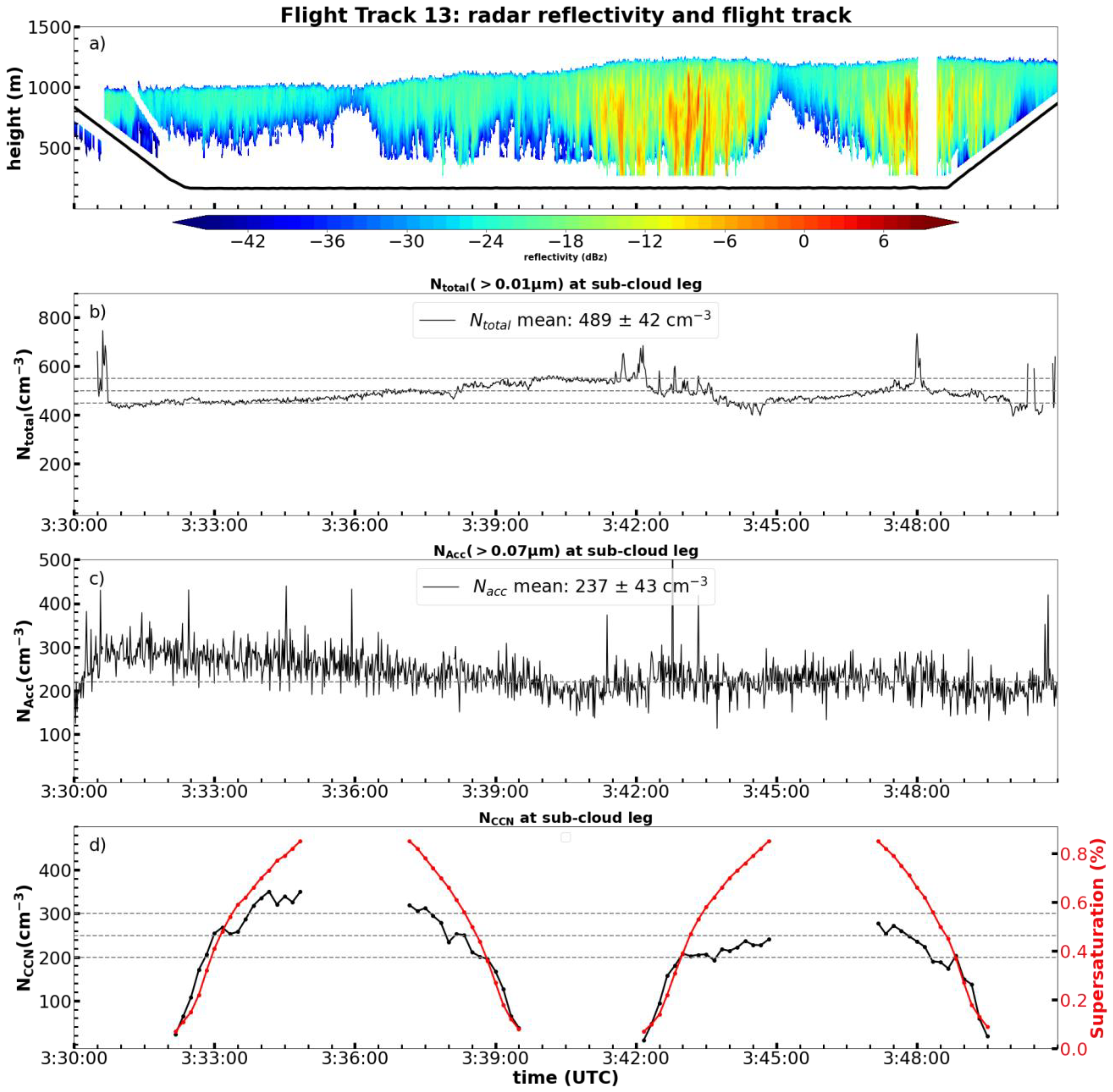
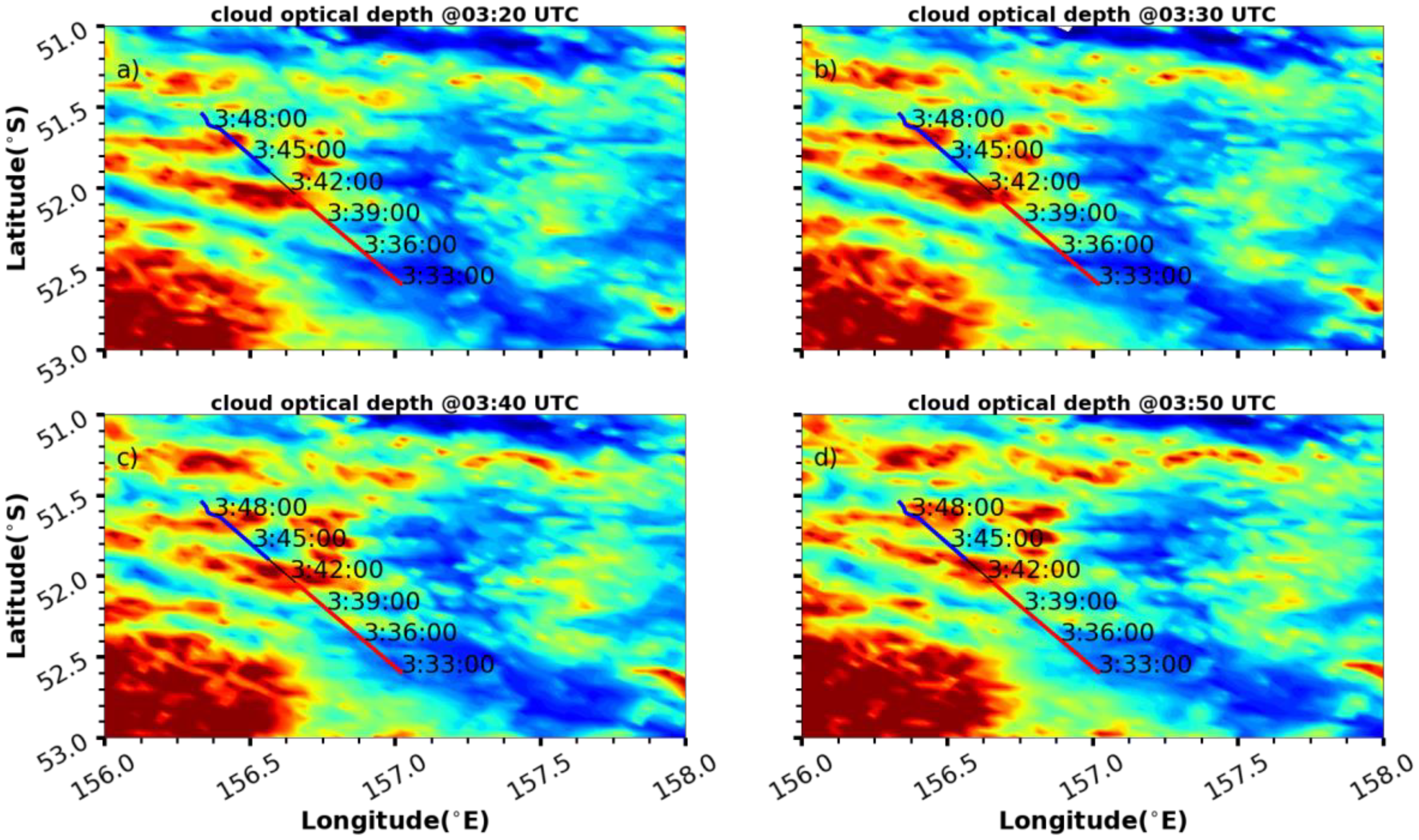
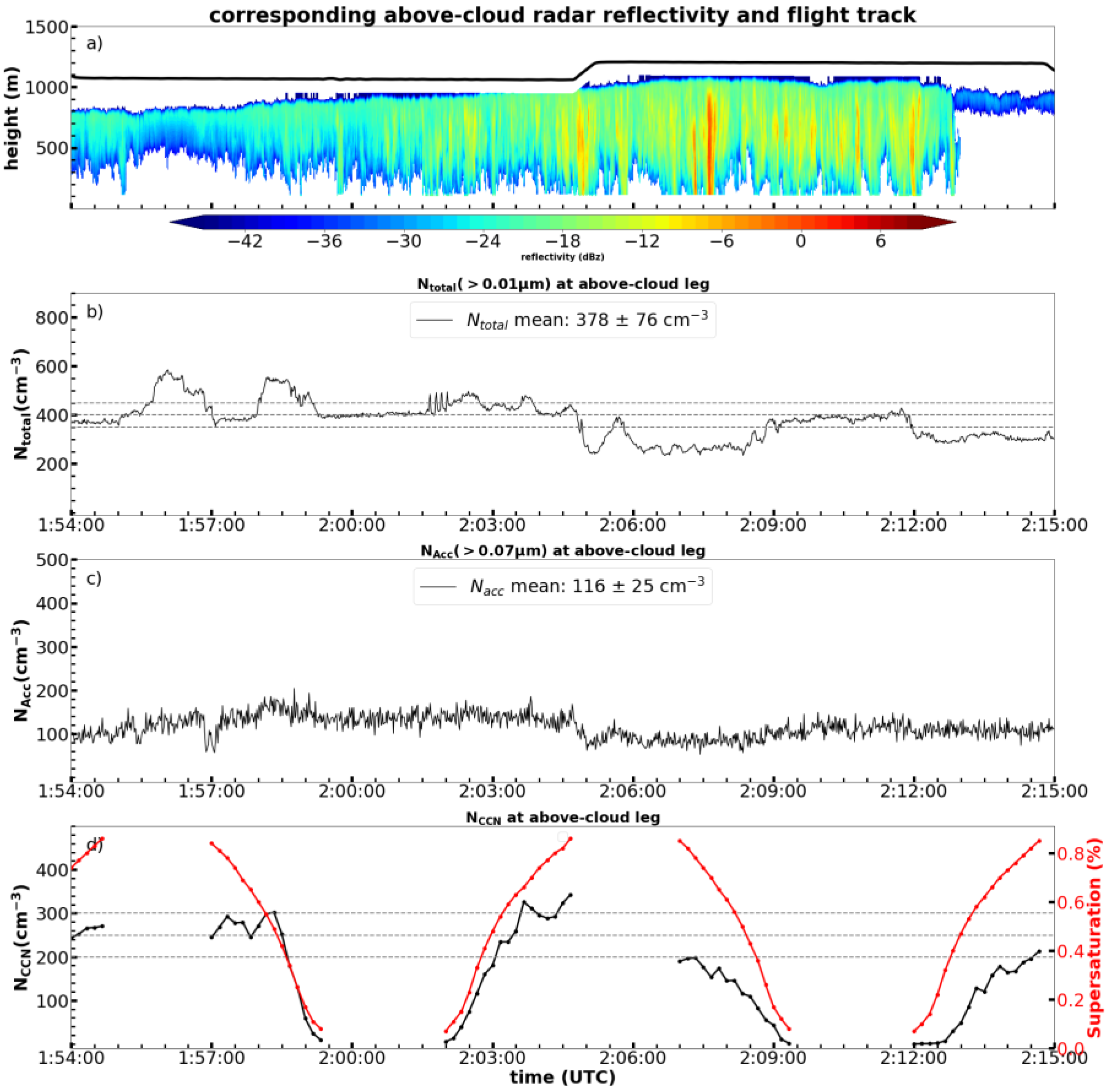
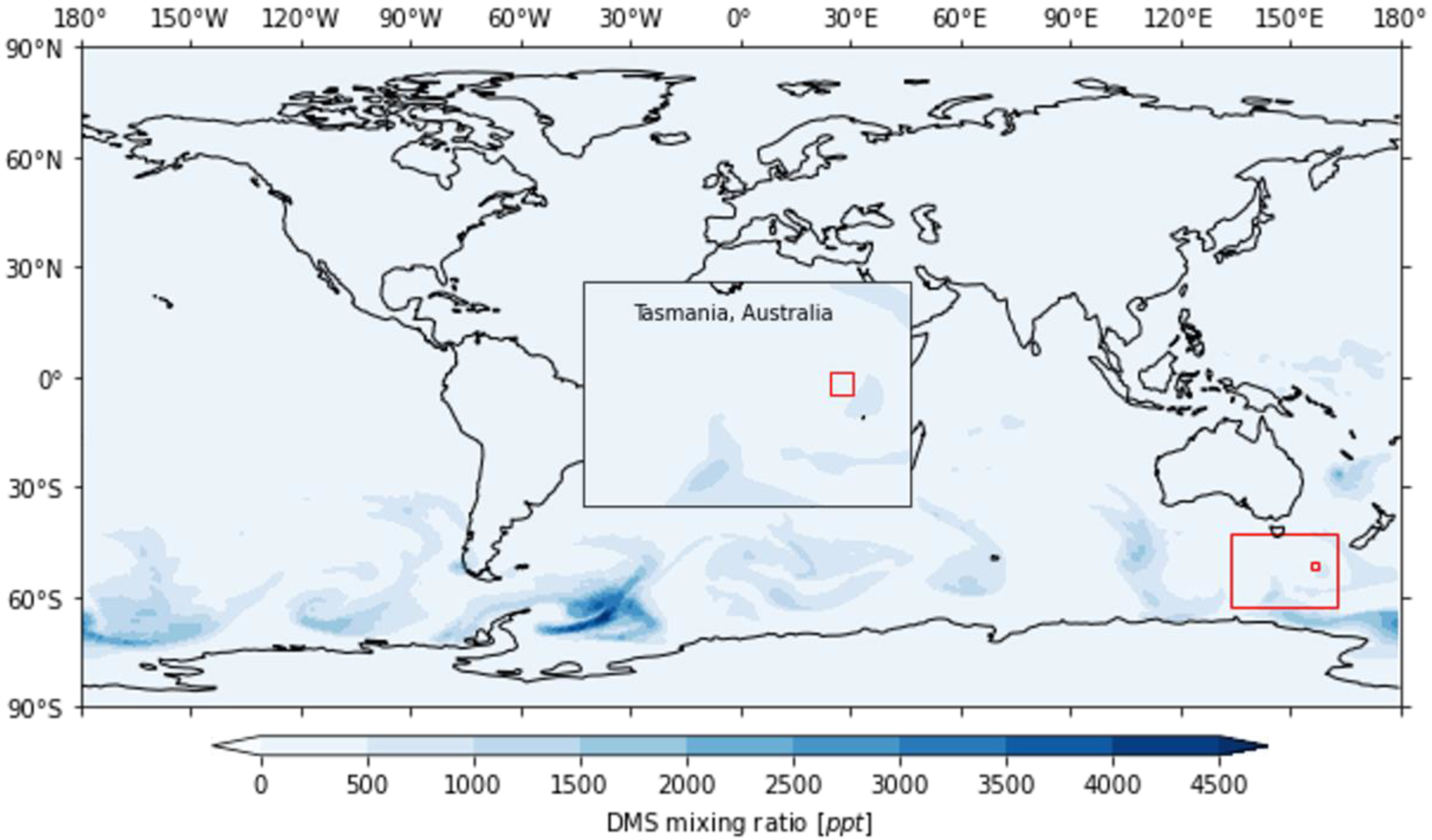
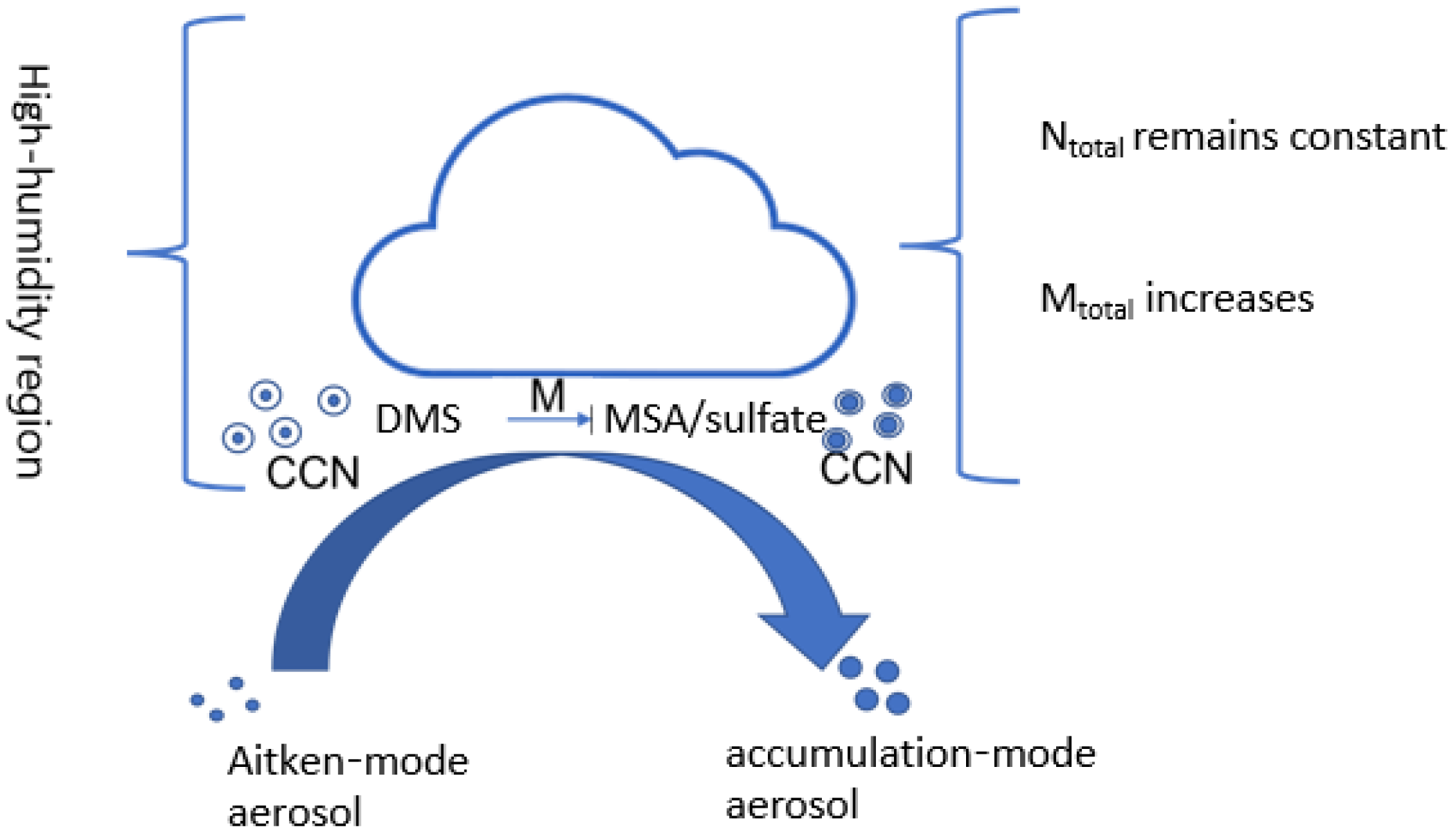

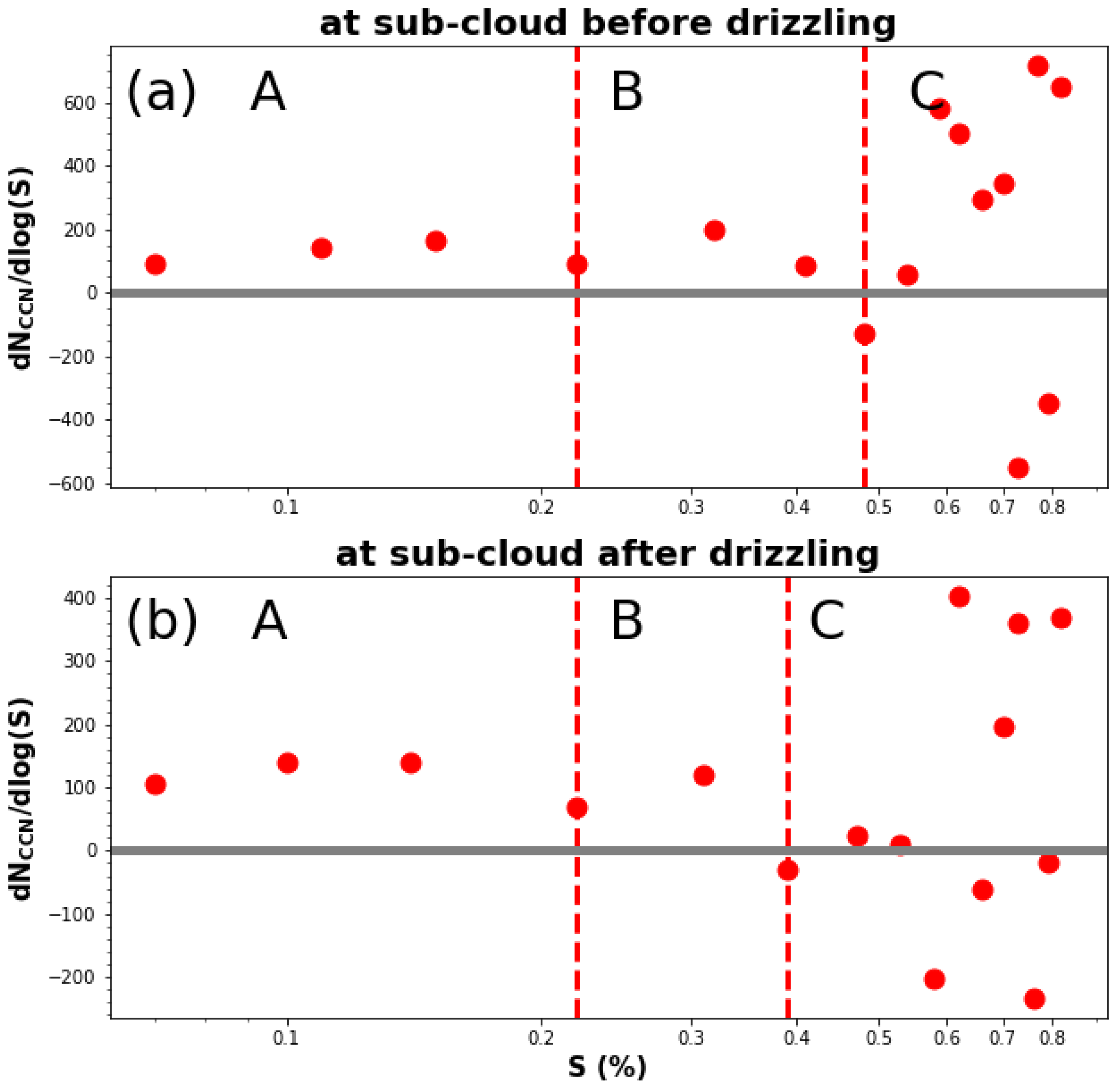
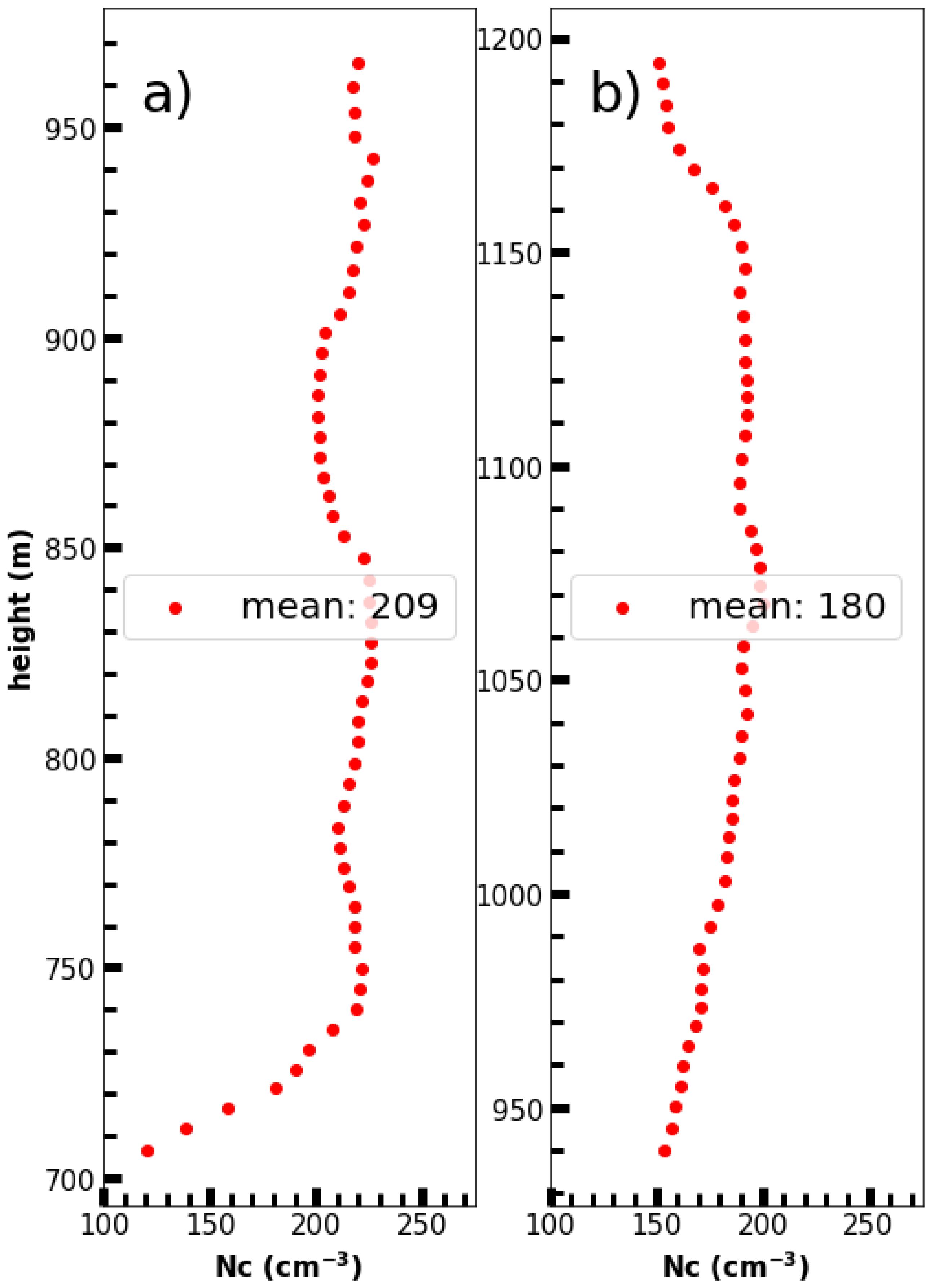
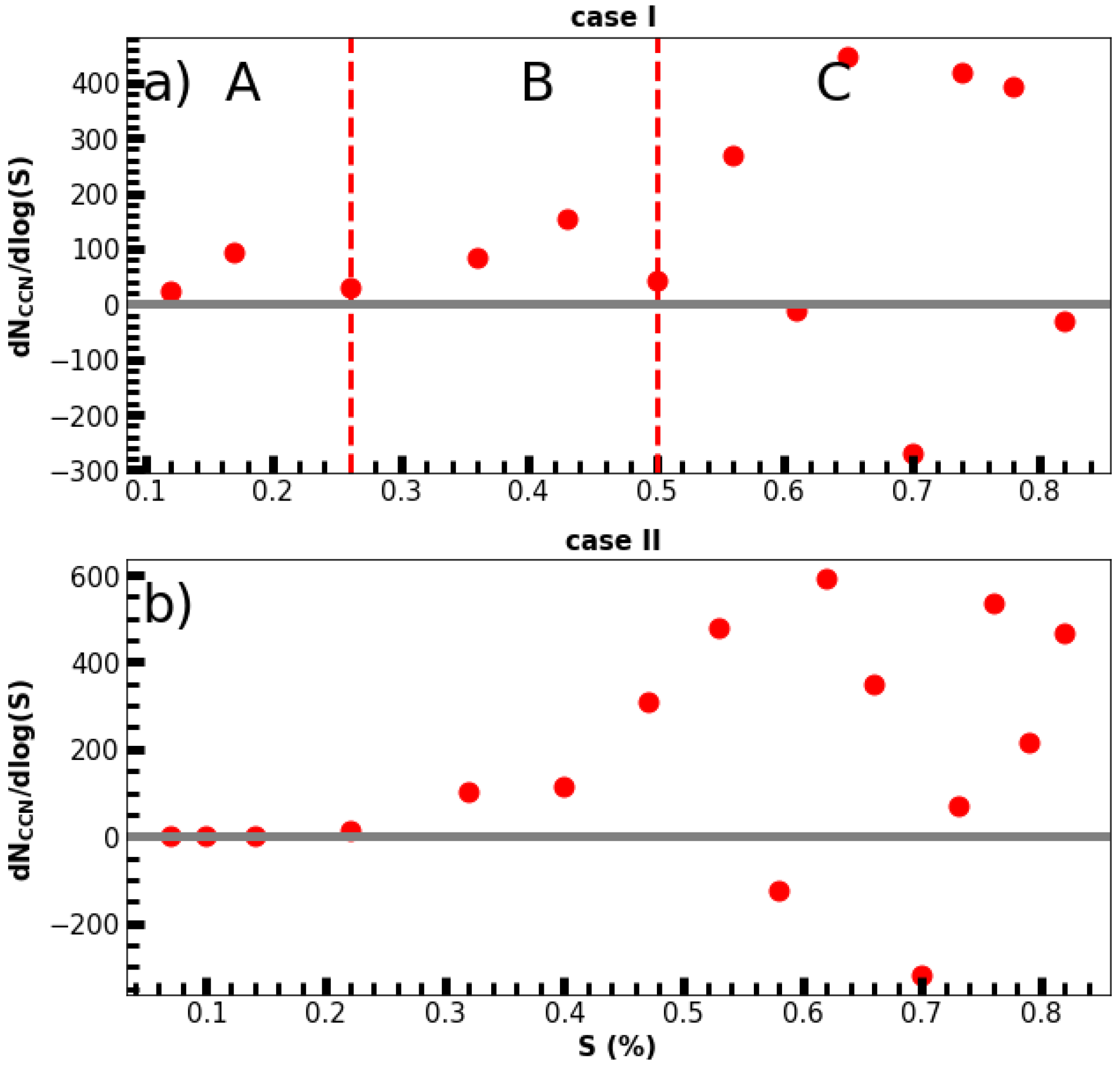
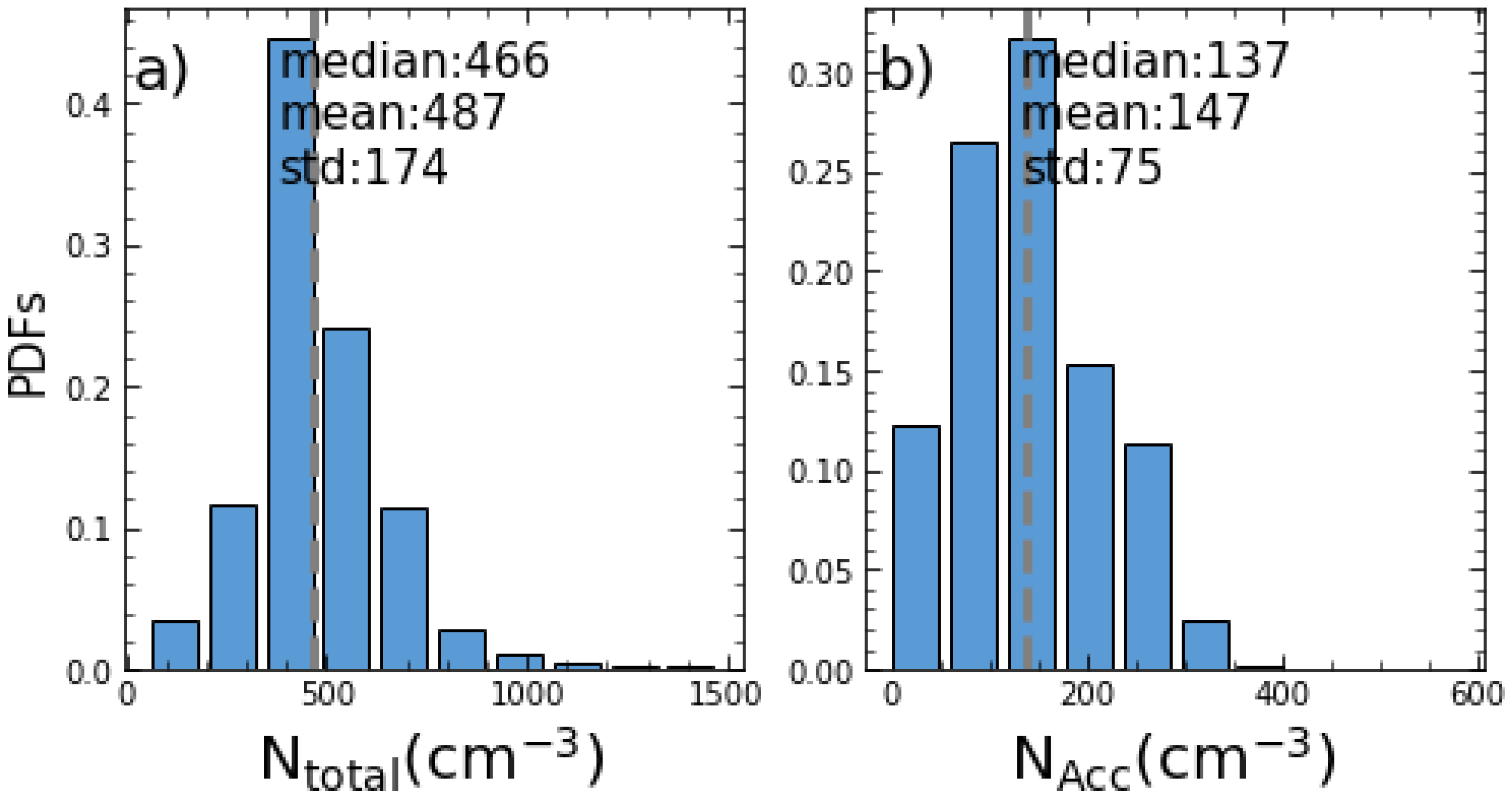
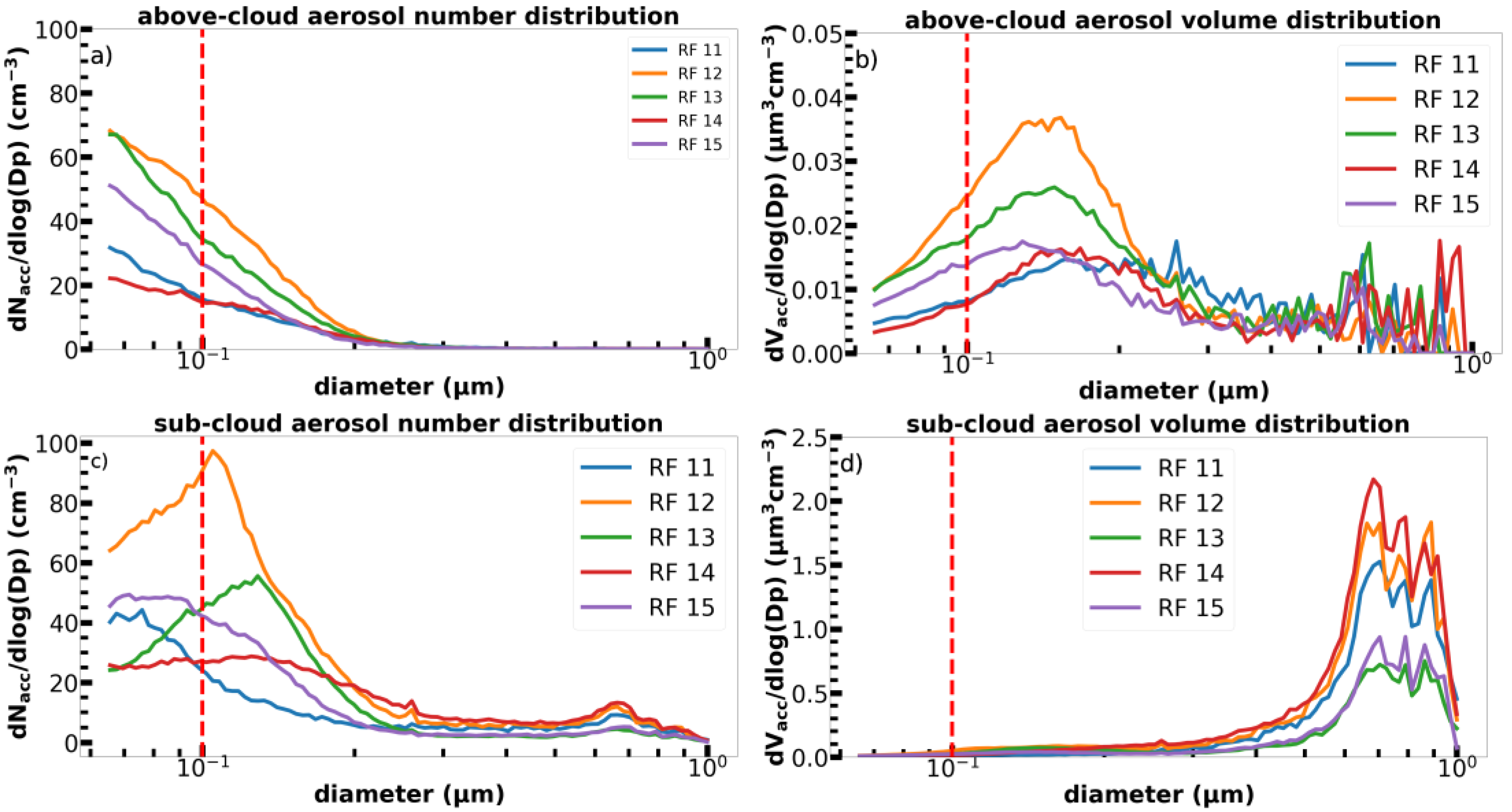
Disclaimer/Publisher’s Note: The statements, opinions and data contained in all publications are solely those of the individual author(s) and contributor(s) and not of MDPI and/or the editor(s). MDPI and/or the editor(s) disclaim responsibility for any injury to people or property resulting from any ideas, methods, instructions or products referred to in the content. |
© 2023 by the authors. Licensee MDPI, Basel, Switzerland. This article is an open access article distributed under the terms and conditions of the Creative Commons Attribution (CC BY) license (https://creativecommons.org/licenses/by/4.0/).
Share and Cite
Zhang, X.; Dong, X.; Xi, B.; Zheng, X. Aerosol Properties and Their Influences on Marine Boundary Layer Cloud Condensation Nuclei over the Southern Ocean. Atmosphere 2023, 14, 1246. https://doi.org/10.3390/atmos14081246
Zhang X, Dong X, Xi B, Zheng X. Aerosol Properties and Their Influences on Marine Boundary Layer Cloud Condensation Nuclei over the Southern Ocean. Atmosphere. 2023; 14(8):1246. https://doi.org/10.3390/atmos14081246
Chicago/Turabian StyleZhang, Xingyu, Xiquan Dong, Baike Xi, and Xiaojian Zheng. 2023. "Aerosol Properties and Their Influences on Marine Boundary Layer Cloud Condensation Nuclei over the Southern Ocean" Atmosphere 14, no. 8: 1246. https://doi.org/10.3390/atmos14081246
APA StyleZhang, X., Dong, X., Xi, B., & Zheng, X. (2023). Aerosol Properties and Their Influences on Marine Boundary Layer Cloud Condensation Nuclei over the Southern Ocean. Atmosphere, 14(8), 1246. https://doi.org/10.3390/atmos14081246





